Game 28 of the Bundesliga was arranged to play during the midweek. Apart from the clash between Bayern and Borussia Dortmund, Leverkusen and Wolfsburg faced each other to fight for the continental competition qualifications. Despite Wolfsburg was only behind Leverkusen, their margin of 12 points before the game was huge. After beating Borussia Mönchengladbach, fans expected Peter Bosz’s men carry the form for another victory.
However, the results might have shocked fans who did not watch the game. Wolfsburg demonstrated solid defence and direct offensive transitions throughout the game. With Marin Pongračić’s double, Maximilian Arnold and Renato Steffen’s goal, Oliver Glasner’s side won the game 4-1.
In this tactical analysis, we will review the tactics of both sides in the game.
Lineups
Bosz slightly rotated his team and switched the formation to a 4-2-3-1. Since there were two centre-backs playing only, Aleksandar Dragović was given the chance to rest. Wendell returned to the team and played as the left-back. At the midfield, Nadiem Amiri played in front of Kerem Demibray and Charles Aránguiz.
Although still playing in a 4-4-2, Glasner had made two changes in his lineup when comparing to the Dortmund loss. The left-wing position was played by João Victor. The partner of Wout Weghorst changed from Daniel Ginczek to Josip Brekalo.
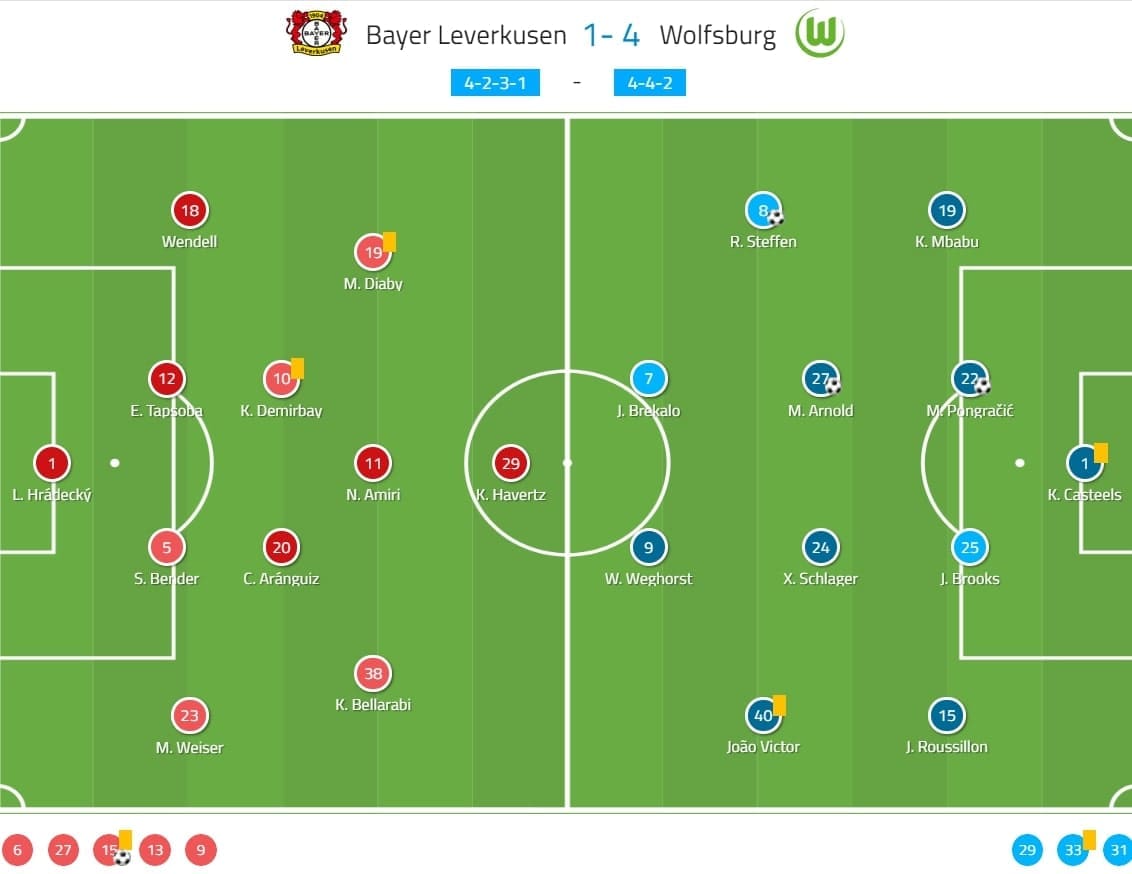
Positional play analysis: Leverkusen
In this game, Leverkusen dominated possession, getting the ball on their feet 66.05% of the time. They also had more passes than the opponents (622-280) and managed to complete most of them (544, 87.46%). However, these stats did not reflect the reality as Bosz’s men could not make good use of the ball. They were a bit dogmatically followed the usual setups of the game and failed to control the rhythm and create dynamics.
Worse still, the offensive approach was not only ineffective in the attack. Defensively, they were exposed because of the far distances between the players. We will explain how Wolfsburg exploited the defence in the coming sections. With the below map, we would give you an idea of their distancing issue by looking at the average positions of the players. Some features were observed as follow:
Firstly, the back four spread very wide, Bosz’s intention was using the full-backs to provide the width and stretch the defence. However, we could clearly see the failure of this plan as both full-backs offered limited contributions in terms of progression. No.23 Mitchell Weiser and No.18 Wendell had strong linkage with the corresponding centre-backs, but none of them connected well with the front players, or even the midfielders.
Another issue was the spacing between centre-backs. By looking at No.12 Edmond Tapsoba and No. 5 Sven Bender’s positions, we could see their strong passing linkage, but they were splitting wide too. This became an issue when Wolfsburg attacked quickly in the offensive transitions, the gap was too big to close.
The last we would try to point was the height issue. Kai Harvetz played as the ‘false-9’ once again, and he tended to appear at the half-spaces. The highest points of the team were often provided by the wingers, but this was suboptimal as even they received the ball, they were far from goal and unable to pose an imminent threat. Also, leaving the central spaces also lost control of the centre-backs. Throughout the game, Wolfsburg centre-backs stepped out as they wished because there was no behaviour for manipulation.
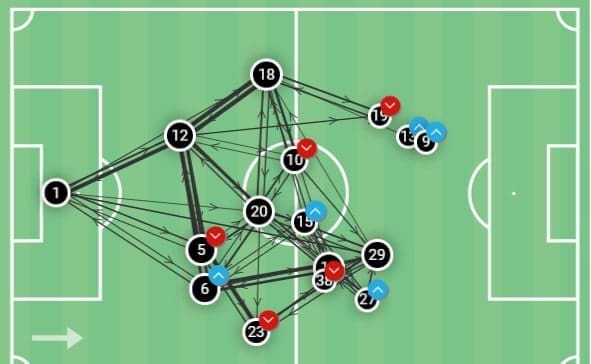
With Havertz playing as the striker, he provided several benefits to the team because of his style. The 20-year-old could drop to the midfield and being the extra man to create a numerical overload. When appearing at the half-spaces, he served as a progressive option to connect plays and released the wingers. However, Leverkusen failed to maximize their advantages because of poor control of rhythm, which was attributed to the solid defence of Wolfsburg.
In addition, it was dogmatic to control the midfield when the team was not trying to penetrate at the centre. Or, the central areas were overcrowded as happened in the second half. Despite the numerical overload at the centre potentially generated spaces in the wide areas, Weiser and Wendell failed to create the dynamics and progress because of poor body orientations and suboptimal positionings.
We try to elaborate on the issues with this example. The Leverkusen numerical advantage of 4 v 2 or 4 v 3 was highlighted. However, the above-mentioned issues also appeared. As the passer, Aránguiz missed the best timing to penetrate between players to find Harvetz. It was not bad to find Weiser, who had spaces on the right either. However, the right-back often received the ball with closed body shape, and this was a pressing trap set by Wolfsburg which we will explain below in this analysis.
We should also note Wendell’s position. He stood near the halfway line, but this was not helping the attack. Since the left-winger, Moussa Diaby inverted to the centre and took the right-back, Wendell should go further forward to create a decisional crisis for Kevin Mbabu. The position he chose was not relevant to this attack, as Wolfsburg strikers covered the passing lane to him.
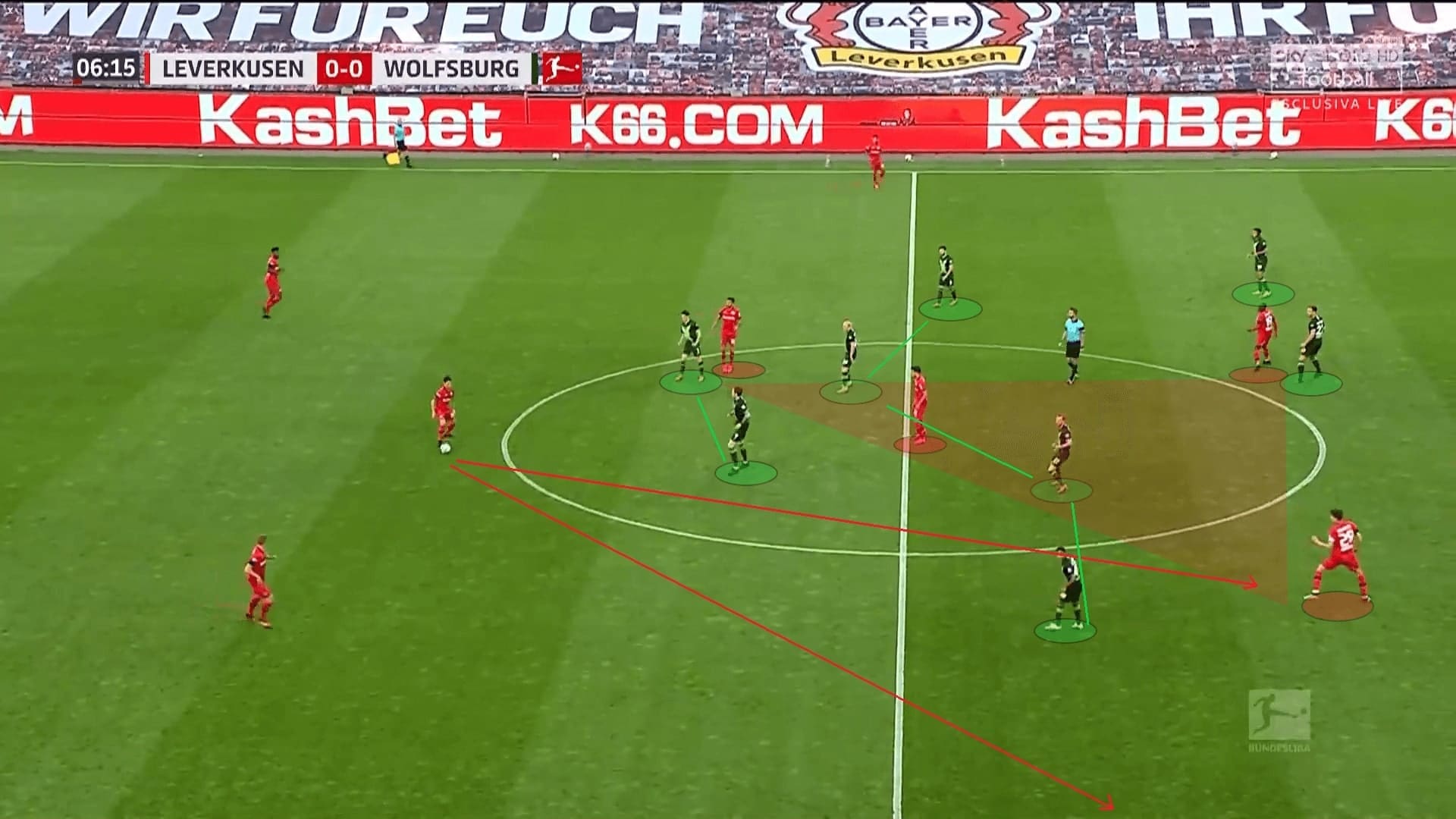
Defensive flexibility: Wolfsburg
Wolfsburg defended really well by drawing this game into a physical one. They have shown their progress in different components: high press, midblock and pressing trap and these troubled Leverkusen’s build-up. Glasner’s team defended in a 4-4-2 shape, a formation that had to spend energy to avoid spaces between the lines being exploited. We will analyze them one by one.
High press
The high press of Wolfsburg was led by either striker, usually Werghost. It was used in the early stages of the game, which successfully either forcing the ball to the keeper or the wide areas. In the former case, the long passes of Lukáš Hrádecký were won by physical challenges of the defenders. Wolfsburg won 48 of their 75 defensive duels in this game (65.75%).
With a 4-2 pressing shape without a very high line of defence, Wolfsburg had to press cleverly to avoid excessive workloads. They were doing well to cover each other, midfielders stepping up to support the strikers, also guiding the direction of the ball. It was easier to force the ball to the right side because both Leverkusen centre-backs were right-footed, they were naturally passing to that flank.
In the first example, Wolfsburg were pressing in a Leverkusen goal kick. All pressing players began at the centre, as they wished to shut down the central passing lanes initially. Werghost initiated the press well. He covered Aránguiz and left either centre-back free, also checking his teammate’s positions to decide the intensity when pressing.
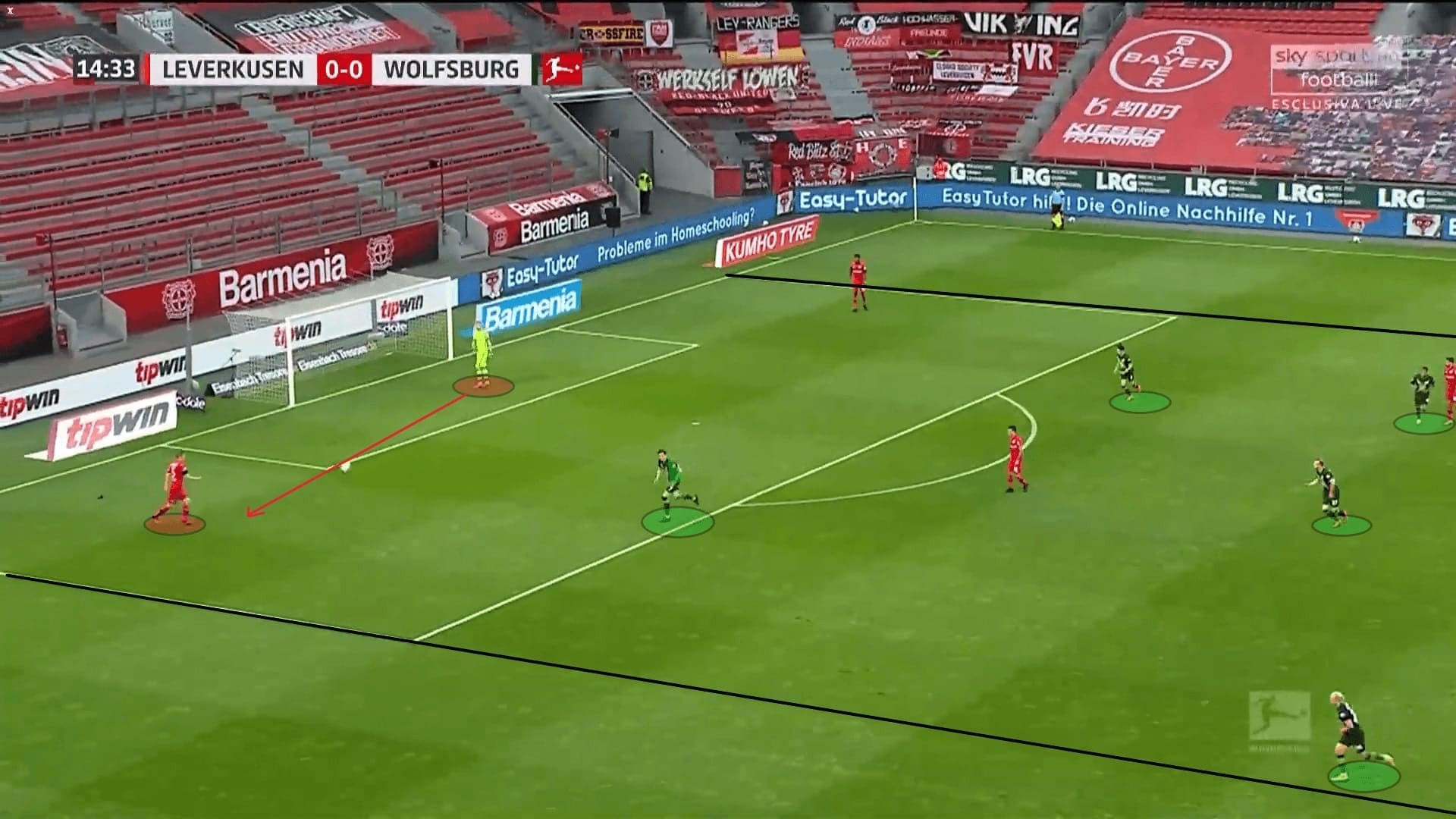
Bender quickly returned the ball to the keeper with his first touch. Now, Werghost started another pressing action by closing covering the passer while pressing the keeper. Meanwhile, Arnold already closed Aránguiz as a cover for the striker.
The other striker, Brekalo was smart enough to delay the press. This was vital as the priority was to shut the midfielder behind while keeping an eye on the other centre-backs. Hrádecký left no choices but to play long, which Wolfsburg won the ball with the physical prowess of defenders.
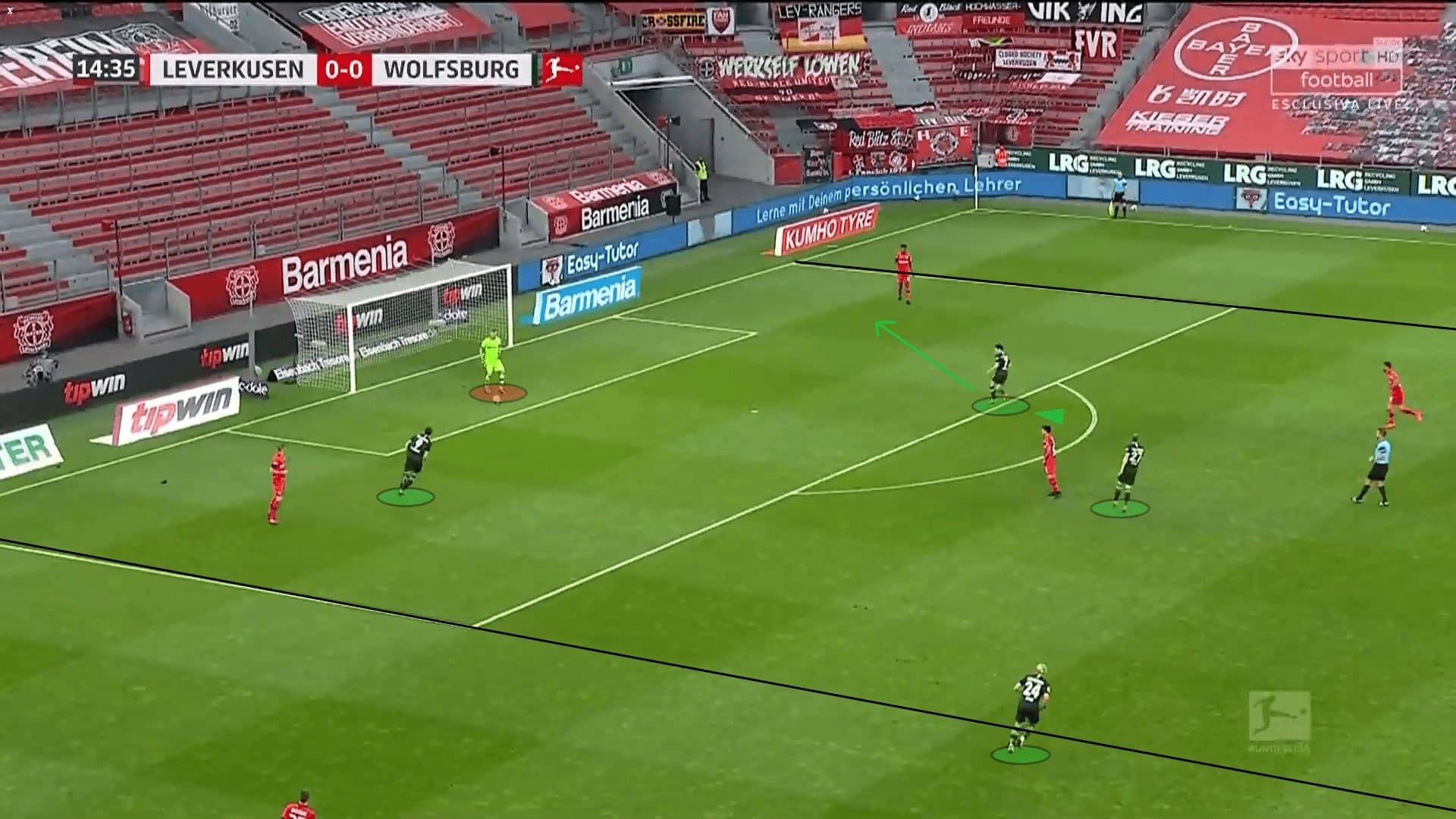
Pressing trap
An alternative option for the centre-backs was to move the ball wide, where spaces were available without Wolfsburg players. However, this was a pressing trap! When the ball was travelling, Wolfsburg also quickly shifted the press to the ball side diagonally. Not only could this compress spaces, but it also closed options of the receiver by pressing from different angles and different heights.
In this example, Bender found Weiser, Wolfsburg were pleased to see. A common problem of Weiser was his closed body orientation when receiving the ball as shown below. The right-back had to shift the ball and adjust his body to a better angle for his next moves, delayed the timing to pass.
From Wolfsburg’s perspective, they were pressing well as the simultaneous press from Werghost and Victor on their targets. Meanwhile, Arnold did his job well to mark Aránguiz by staying behind him, which was potentially a second passing trap if Weiser passed centrally.
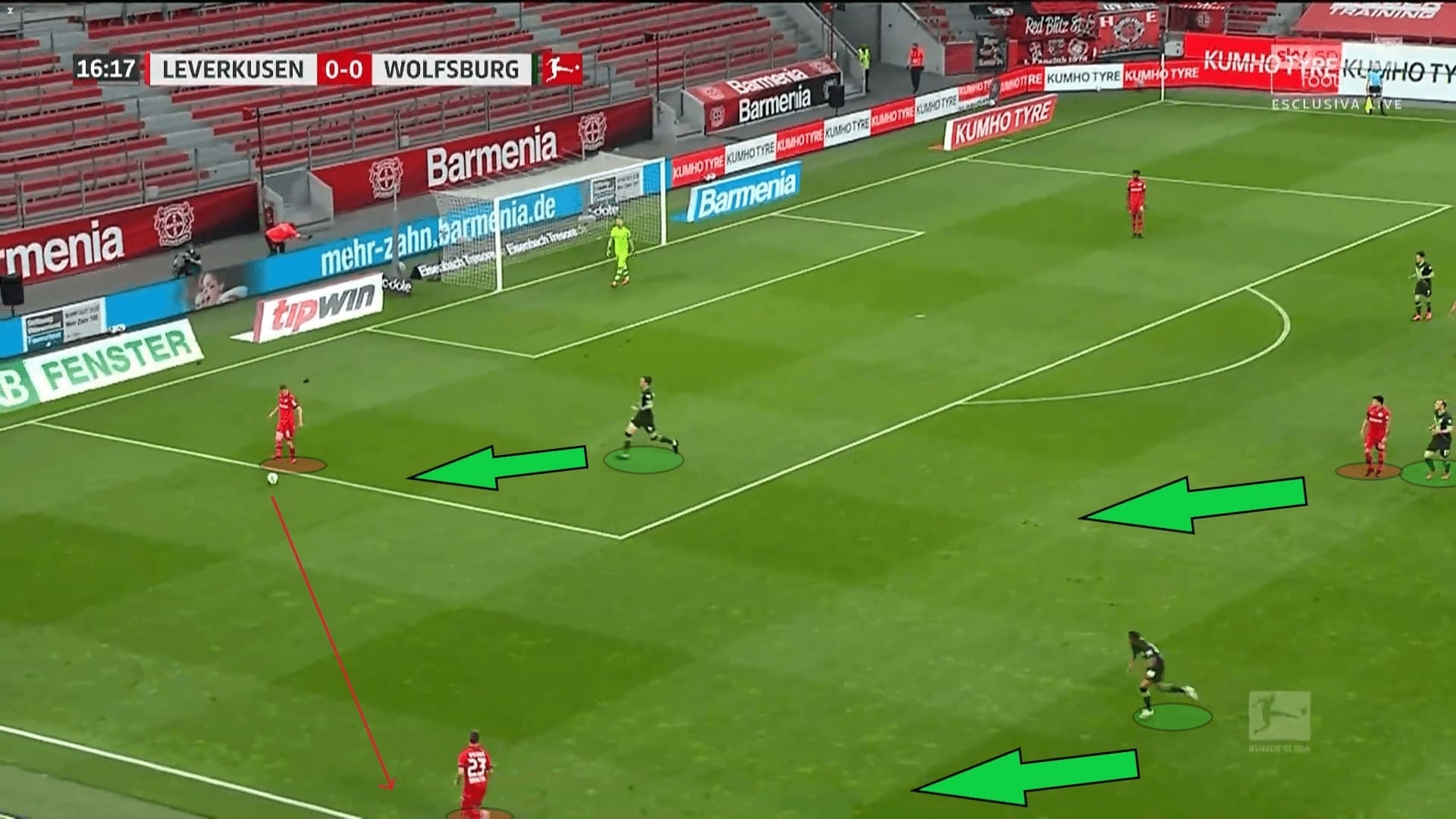
In the above case, Victor arrived soon Weiser received the ball, which left the right-back no choices and spaces were closed. In our second example, we investigate the situation when the pressing trap was utilized in deeper areas.
The close proximity of the Wolfsburg players allowed the team to stay compact, especially thanks to the discipline of strikers. As highlighted, spaces around the ball were controlled and midfielders were man-marked, which served as a second pressing trap. Any soft and reckless pass towards the centre was extremely risky. Again, Werghost and Victor demonstrated simultaneous press, and Bender was eliminated as a result.
In fact, these situations gave Leverkusen chances to progress as Weiser could find a progressive option. However, this fallen to the pressing trap as defenders would step up and press Harvetz or Karim Bellarabi tightly. Since the receivers could not turn, the attack lacked progression. What helped Wolfsburg to win the ball back was the player abundancy on the ball side, the forward pass triggered the press in the wide areas by six to seven Wolfsburg players.
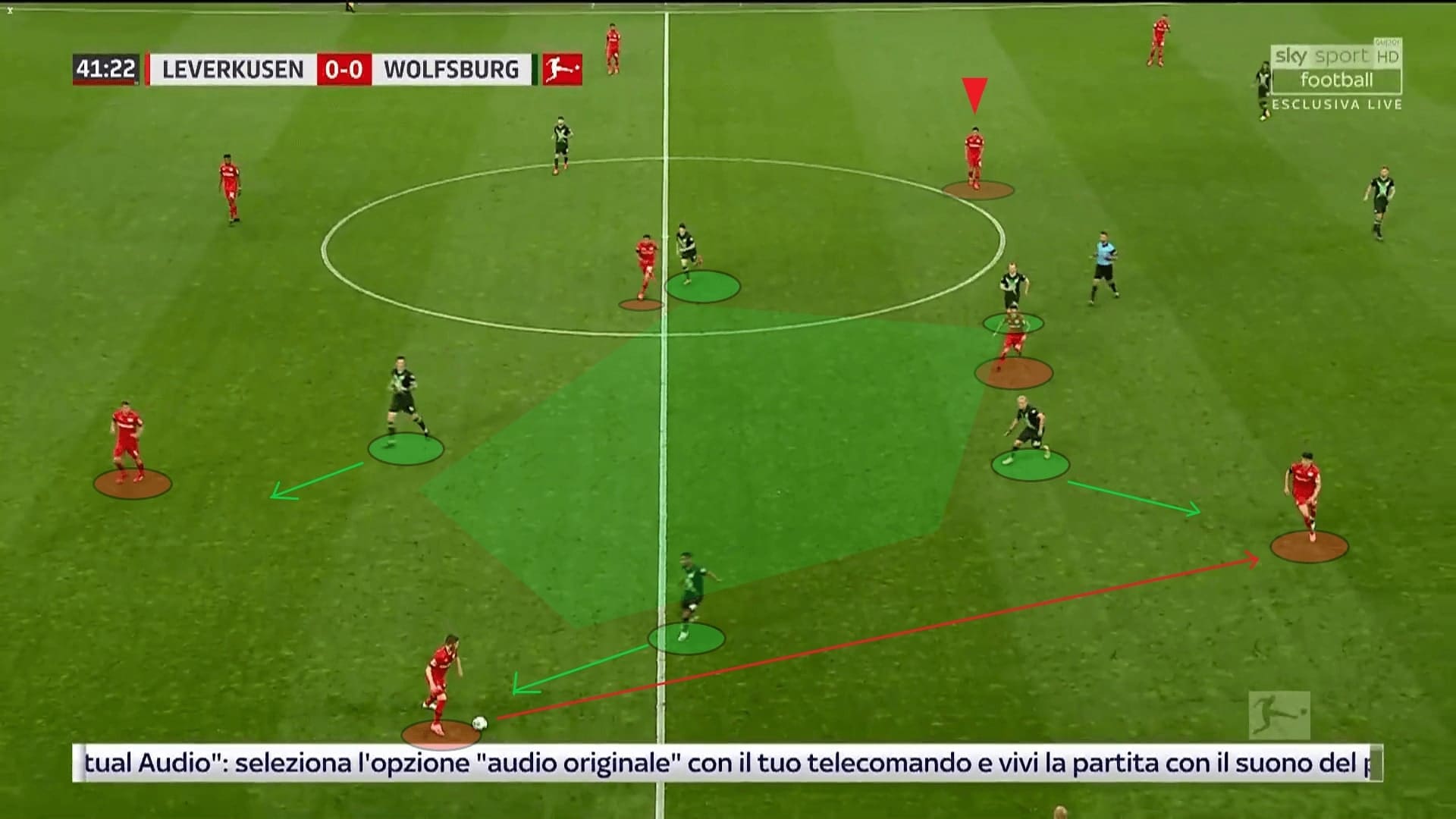
The success of the press was reflected by the ball loss events of Leverkusen. The below images were the ball losses maps of Weiser and Leverkusen.
Weiser gave away possession nine times in only 45 minutes, ranked third in the team. As shown in the map, seven of his losses occurred in the area where Wolfsburg set the pressing trap.
On the right, the graph has shown Leverkusen gave away the ball often on the right, which accounted for 45% for the total. A high proportion of ball losses events occurred within the pressing trap, which was highlighted in yellow. The shapes of the events represented the events that led to ball loss, you could see a lot of squares as Wolfsburg were recovering the ball by defensive duels.

Midblock
The function of this midblock mingled the concept of the pressing traps as mentioned above. In general, the objectives were similar: closing central spaces and forcing the ball wide. To maintain compactness and reduce spaces between players, both wingers tucked to cover the half-spaces initially. Only when the ball was moved wide, they jumped to the full-backs. The shape was still a 4-4-2, with Werghost and Brekalo staying very close to the second line. This contained players within the block and prevented their exploitation of central spaces. Any reckless or soft pass would trigger the press, and this helped Wolfsburg to win the freekick for the second goal.
The midblock was illustrated with this example, which was in a 4-4-2 shape. Both strikers have done their job by covering both pivots. This was vital as Arnold and Xaver Schlager had to cover players behind, such as the inverted wingers and Harvetz.
Given there was no behaviour from Leverkusen to control the last line, the right-back and centre-backs of Wolfsburg were free to position themselves higher and reduced spaces between the lines. Since the initial central options were eliminated, the ball was likely to play wide and this would fall into the pressing trap.
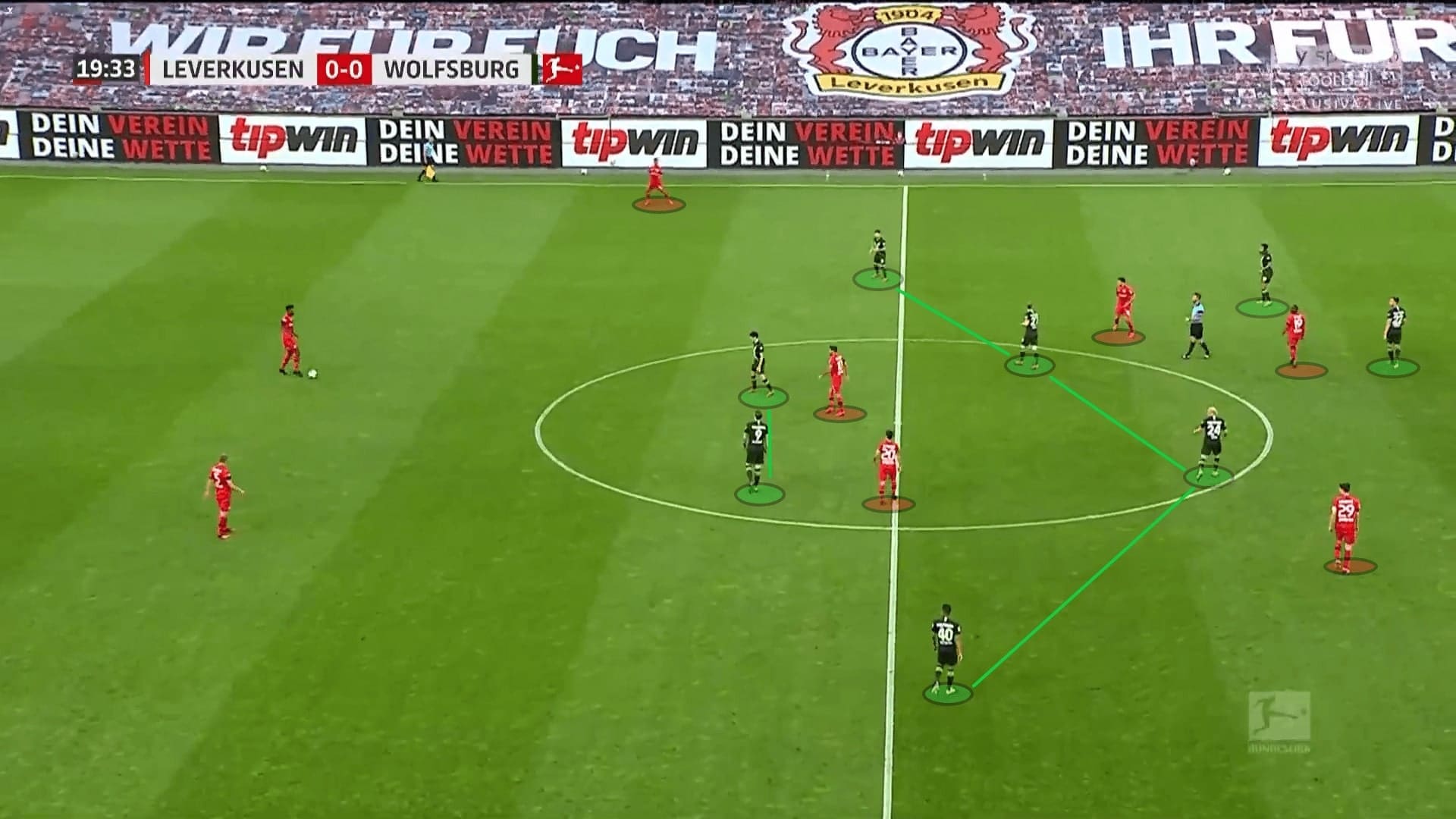
Offensive transitions
Wolfsburg only had 280 passes in this game, and 16.79% of them were long passes. It was clear that they were not trying to play out from the back. What makes their attack looked threatening was their dominance in the offensive transitions. They fully exploited the structural issues of Leverkusen and reached the box very quickly.
So, where were spaces available? Usually, they could be found behind and around the full-backs, or between the centre-backs when Bender left his partner to cover Weiser. Therefore, the attacks of Wolfsburg targeted the wide areas, and also supported by overlapping runs. This was how they scored their third goal.
In the below image, Wolfsburg won the ball high and this became a counter-attacking opportunity. We should pay attention to the directions of the supporting runs. All Wolfsburg players were clear on their duties: do not go near the ball as this attracted pressure. On the contrary, run to spaces and stretch the defence was the mission.
Therefore, we could note there was a run between the central defenders, as Dragović was pulled out by the carrier. Another run occurred behind Wendell, which Steffen stayed at the left-back’s blindside until he scored the header. A supporting run for the carrier was an overlapping run, which Leverkusen players were exhausted to track, and Victor provided with the assist.
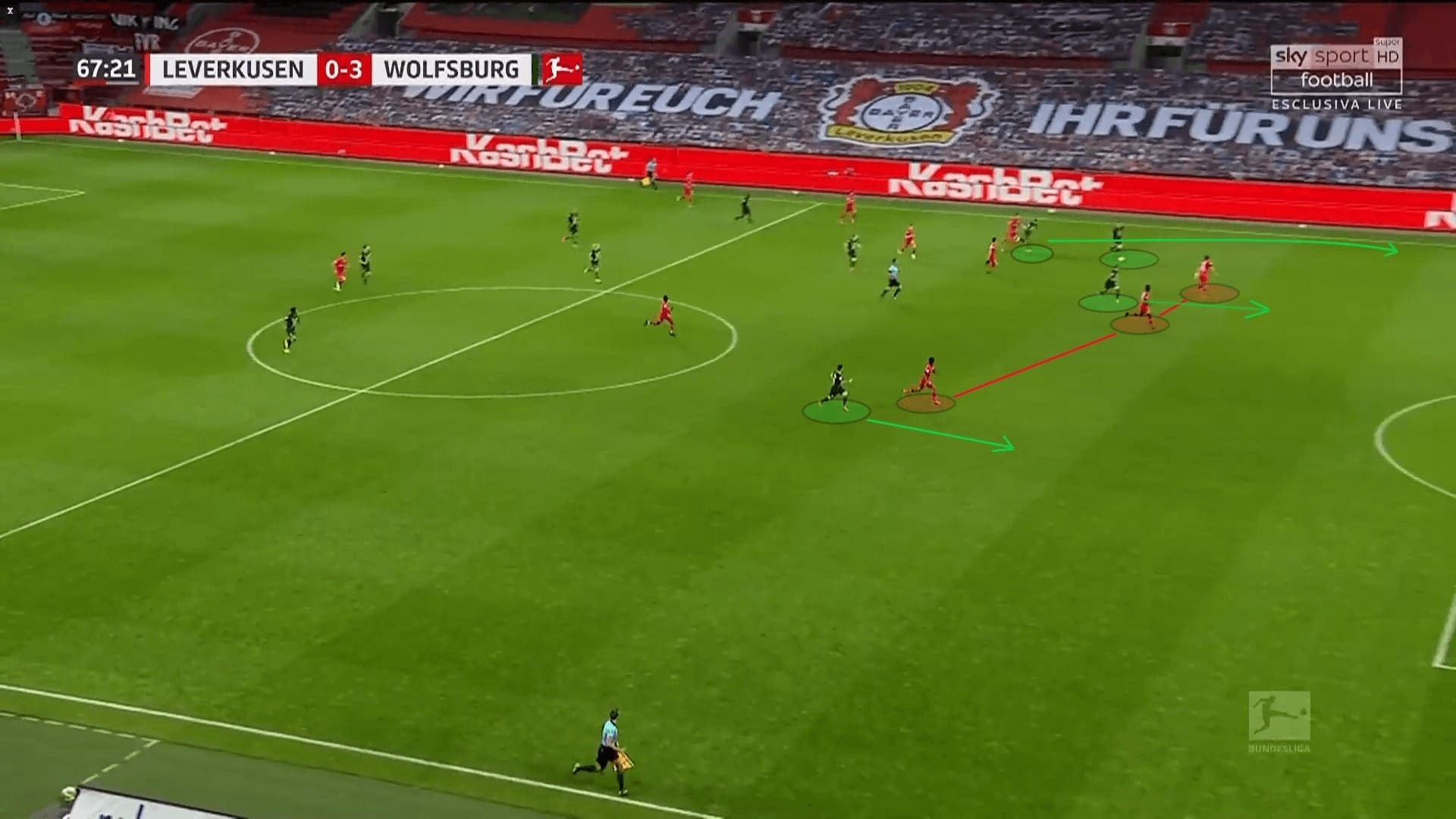
Another setup that impressed us in the Wolfsburg transitions was their behaviour to create a decisional crisis for defenders. Once regained possession, Glasner’s men ran towards the defensive line with full speed. This created several benefits, including generating spaces for the carrier and hindered defender’s behaviours.
For example, Mbabu was free to carry the ball forward as Brekalo pinned Wendell. These often resulted in a half-space runs because of the 2 v 1 or the Wolfsburg right-back was free to cross. The Leverkusen midfielders could not physically match and counter-press in the transitions.
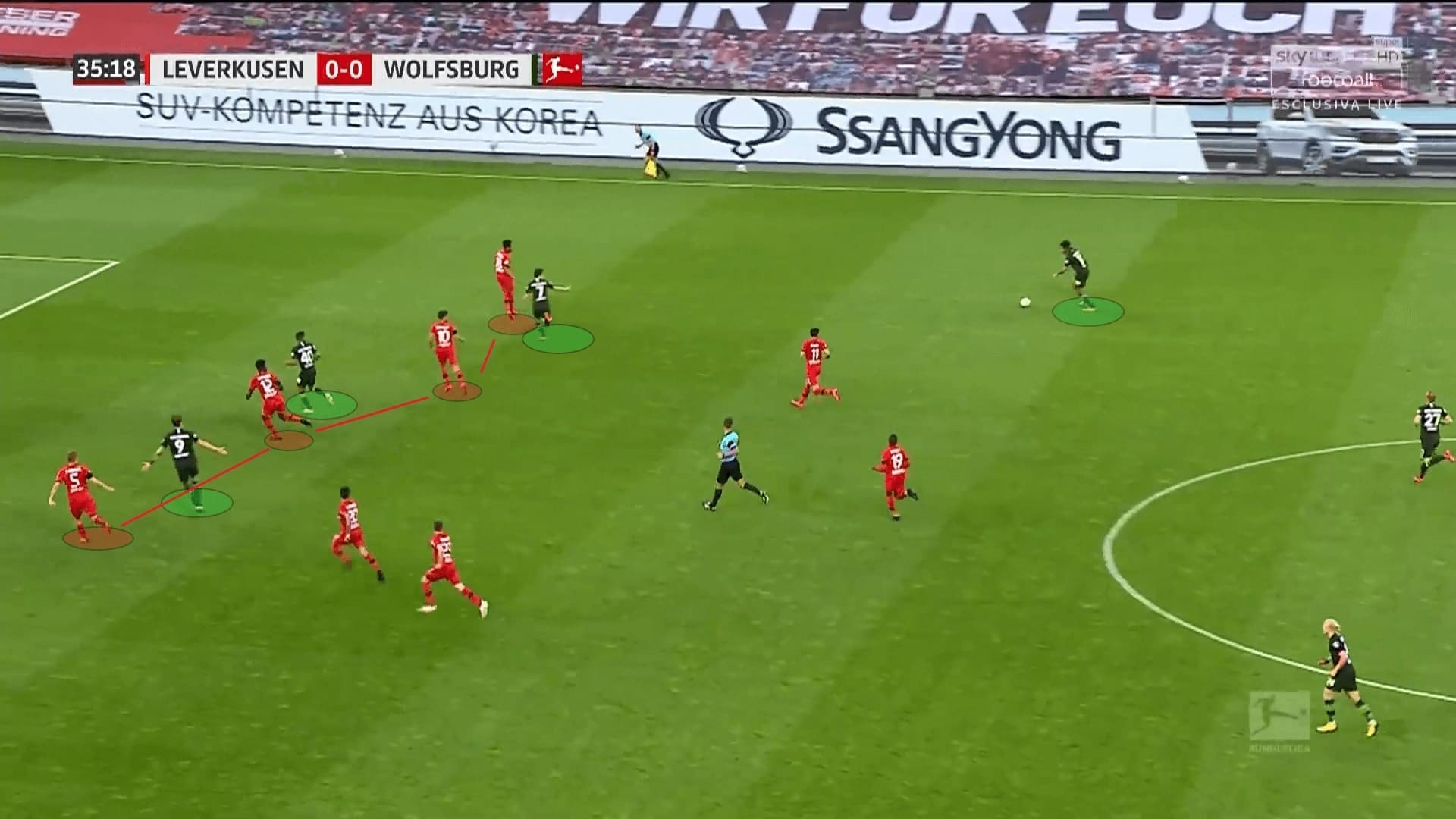
Tactical adjustments of Bosz
Despite conceded three in the second half, Leverkusen did better offensively after Bosz made adjustments. The former Ajax coach switched the build-up shape into a 3-2 at the backline, with Aránguiz dropping between the central defenders. This helped Leverkusen generated numerical superiority and passing options in the build-up phase.
With the below example, we have a clearer picture of the benefits. As Aránguiz positioned himself deep, the centre-backs could move to half-spaces with connections. At the half-spaces, there were more passing options and the passer could face the opposition goal. In this case, there were at least three options, and what made this valuable was the potential to break the block by passing between players.
Furthermore, the passer should be freed from pressure because of the numerical advantage created with Aránguiz, it was a 3 v 2 on the strikers. In this case, Werghost and Brekalo were far away from Tapsoba and the centre-back had rooms to pick his option.
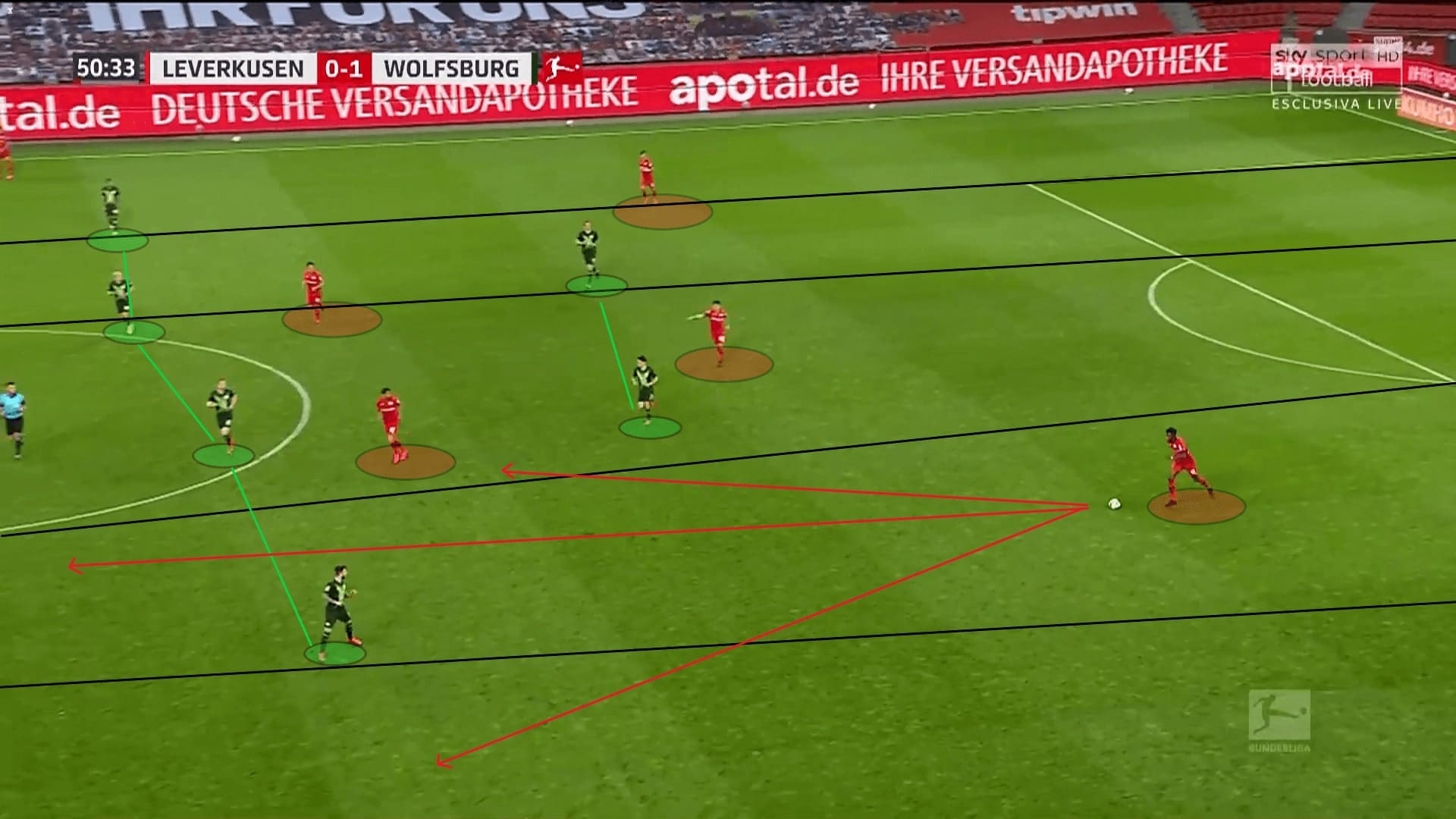
Although Harvetz would be pleased to receive forward passes at the half-spaces from the central defender, this was not the case. Instead, Leverkusen progressed by utilizing the benefit of a back three. The centre-backs were given spaces and they were encouraged to carry the ball forward.
This helped Leverkusen to beat the pressing trap. When bringing the ball forward, the central defender would draw the corresponding winger out as the strikers were far away to access him. As a result, the pressing trap was broken as the full-backs were free from the markings of wingers. In this example, you could see Dragović drew Victor out of possession, and he passed the ball wide. The right-back (or wing-back) now had spaces to receive the ball for further progression.
However, some issues such as the power of passes and the body orientation of the receiver were occurring in the same way. Despite having a better structure to play out from the back, the fluidity of attack was limited.
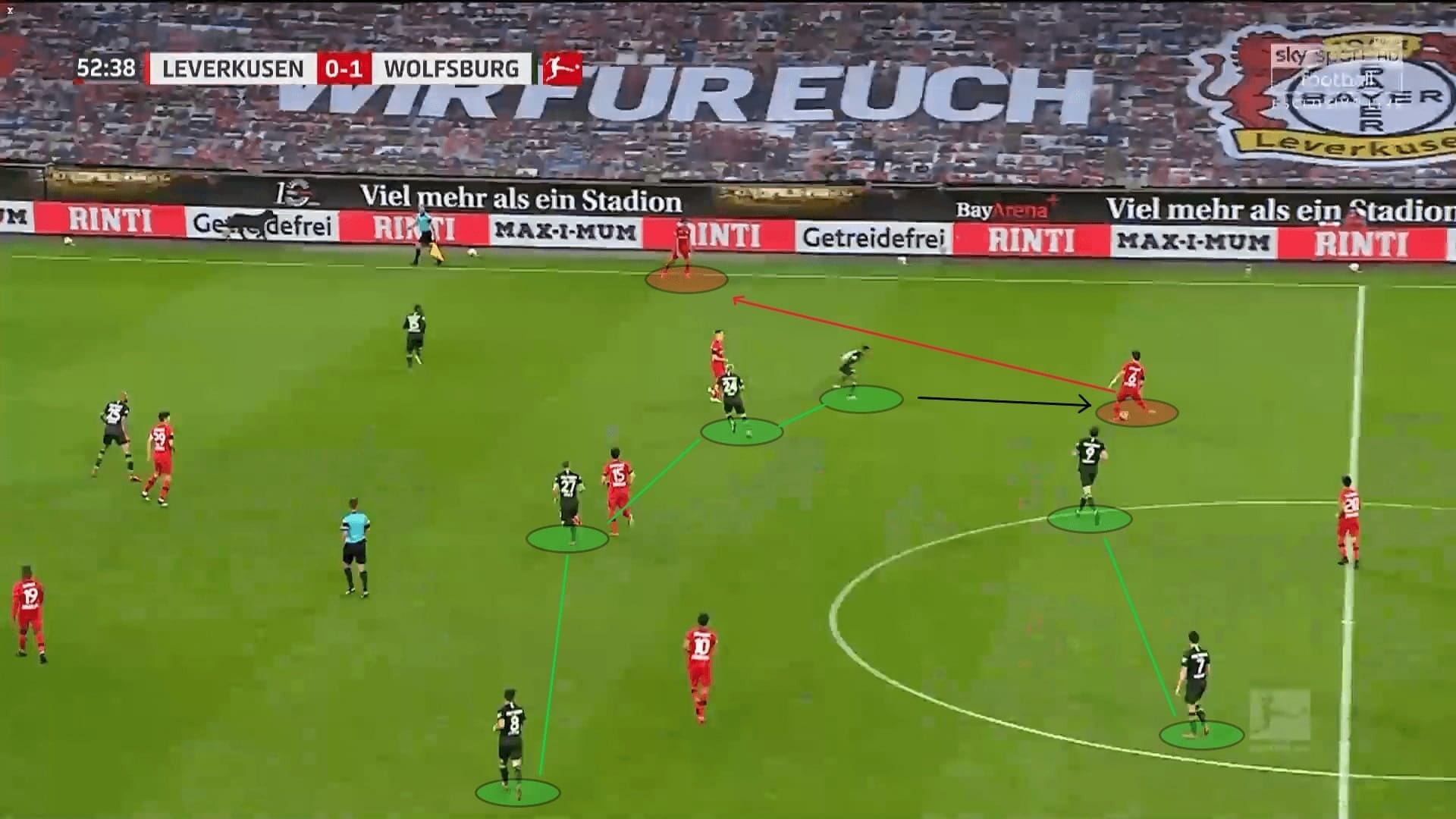
On the other hand, Leverkusen looked to commit numbers on the ball side when the ball was moved wide. Then, the weak side winger, who was usually Diaby would offer the height of the attack by coming to the centre. In fact, this change helped the former PSG man to receive the balls for a couple of time, also created a good chance to equalize. In this example, Diaby’s utilize his pace to run behind the defence when the majority of Wolfsburg players were absorbed to the ball side.
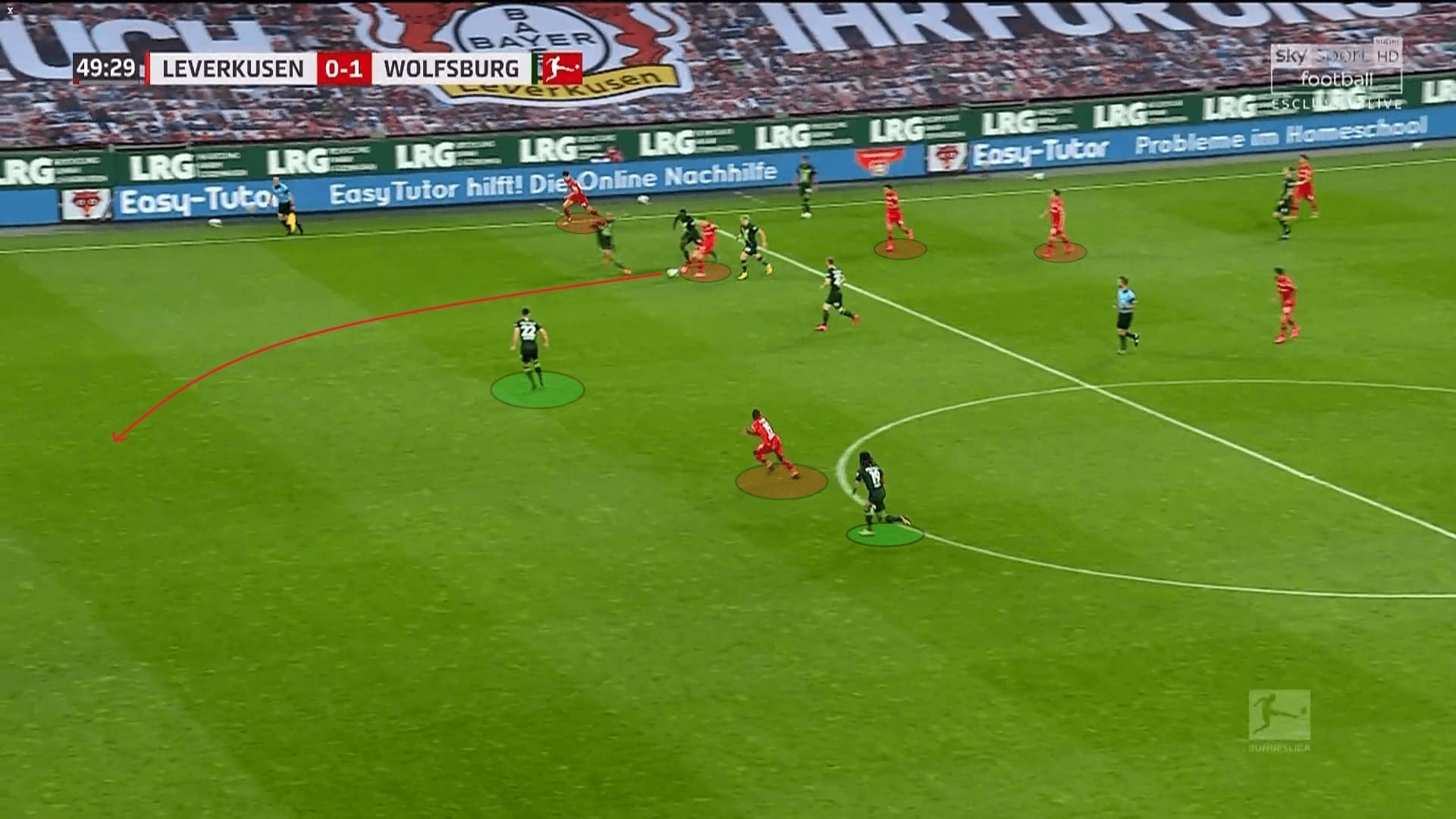
The decisive set-pieces
The performances in the set-pieces made a huge impact on the flow of the game. With Pongračić’s goal before the half-time, Wolfsburg managed to continue their defensive tactics and Leverkusen were forced to attack. In this final section, we highlight some common features on how Wolfsburg prepared their set-pieces tactics.
By drawing similarities in both goals, we could identify that Tapsoba was the target to hit. The young centre-back was not good enough to defend spaces in front of him. This weakness was maximized because of the setups of Wolfsburg.
In both goals, another centre-back: John Brooks positioned himself in an offside position initially. At the meantime, Pongračić stayed at the edge of the penalty box.
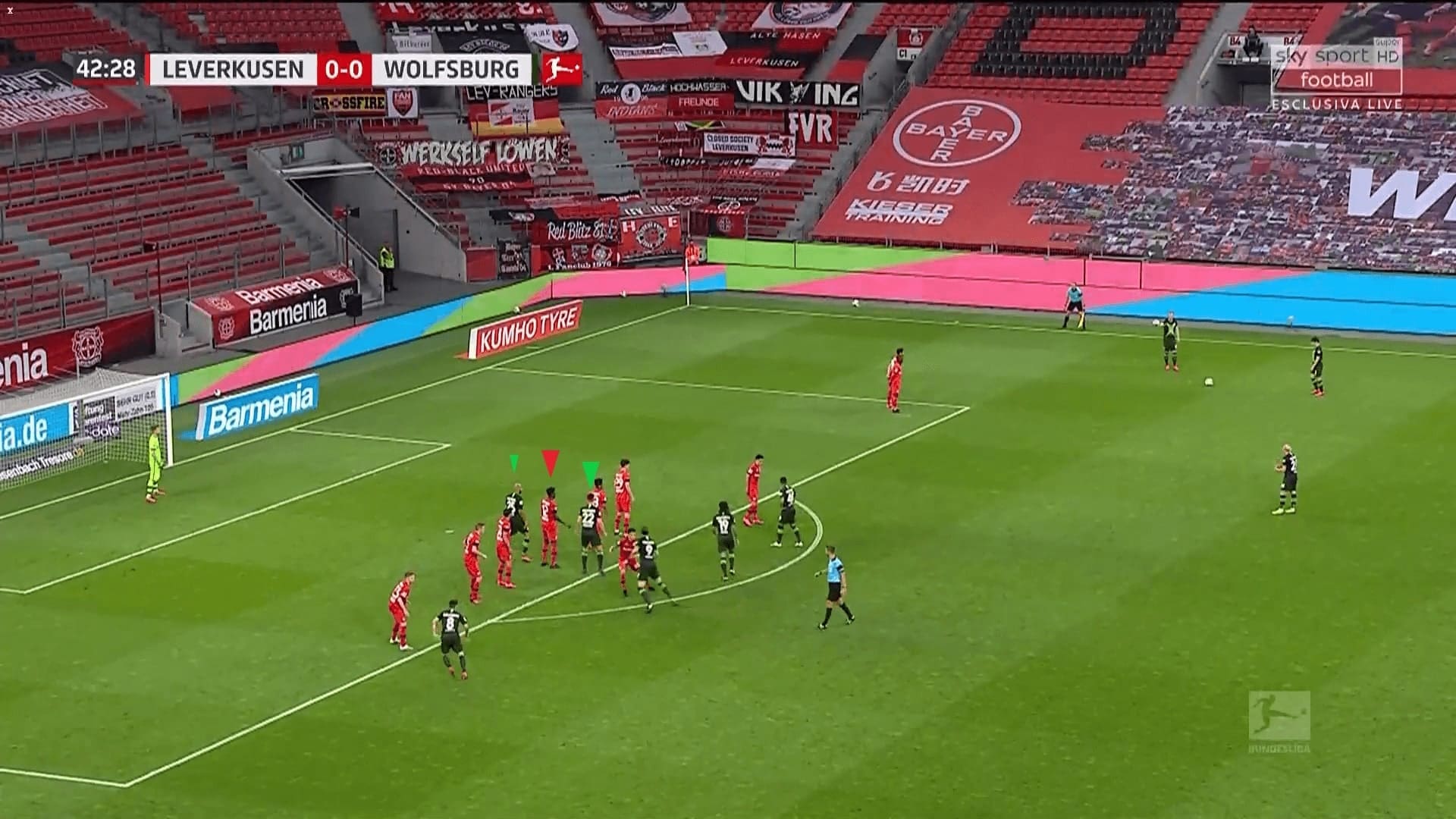
Once the ball was played, Brooks went to block the access of Tapsoba, while Pongračić ran into spaces in front of Tapsoba to score.
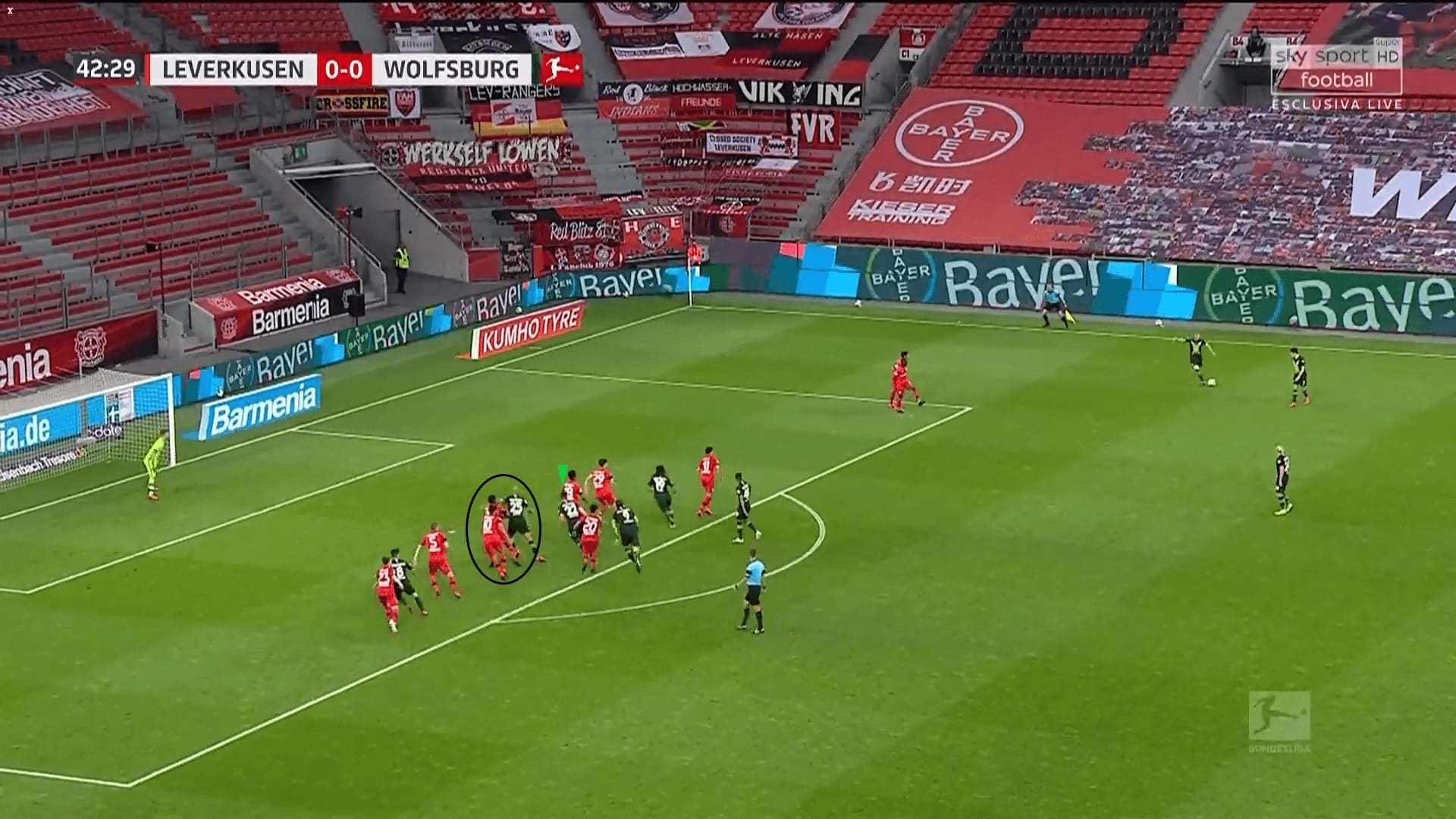
The fourth goal was a similar routine. The starting positionings of Brooks and Pongračić were same, one was staying at the offside position and the other one was at the edge of the penalty box.
Pinpoint deliveries from the taker made sure the ball travelled to spaces in front of Tapsoba with a reasonable height, Pongračić was unmarked in both cases as his initial positionings were away from the line. Leverkusen were also paying too much attention to Werghost. Again, Pongračić ran into spaces in front of Tapsoba and headed the ball, it was poor space protection from the defender.
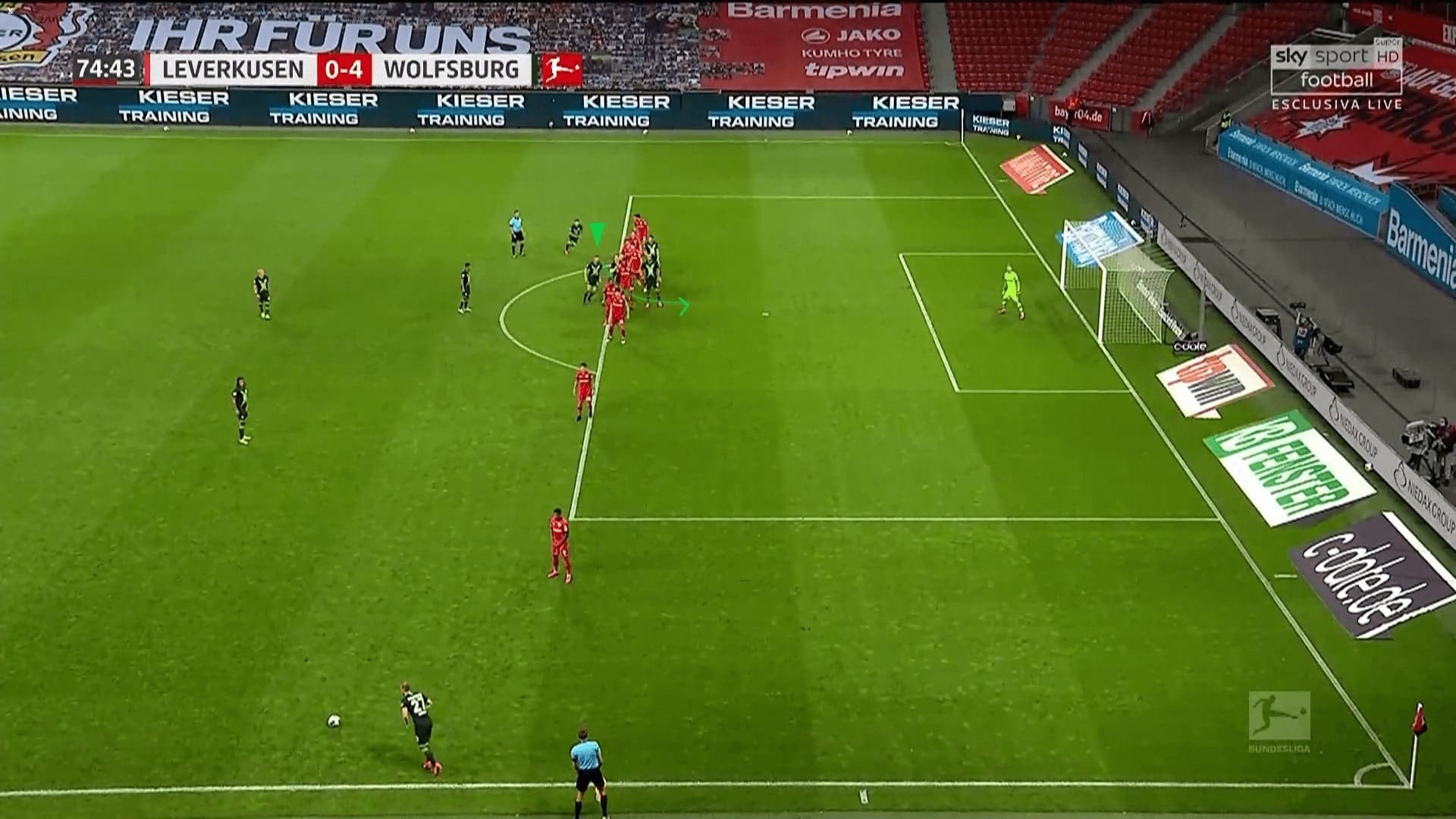
Final remarks
It was another story that told possession was not everything. Passing for the sake of passing is meaningless when no progress was achieved. This game exposed many issues of Leverkusen’s build-up play. They could not find the free player at the right time, did not have any movements to manipulate the second and last lines of the defence. When being isolated, neither Diaby nor Bellarabi was able to create the dynamics. These issues contributed to their offensive inefficacy. Defensively, they were vulnerable because of the opened shape in the build-up. Since giving the ball away in unfavourable positions, spaces were all around during possession turnovers. In addition, with the poor defence in set-pieces, Bosz’s team conceded four goals.
Wolfsburg were doing well this game. The players were fully committed to defending with discipline, intensity and coordination. It was impressive to see their demonstration of different defensive methods, which all of them proved successful. Their strong performance in this game kept them in the fight of continental competitions qualifications.





Comments